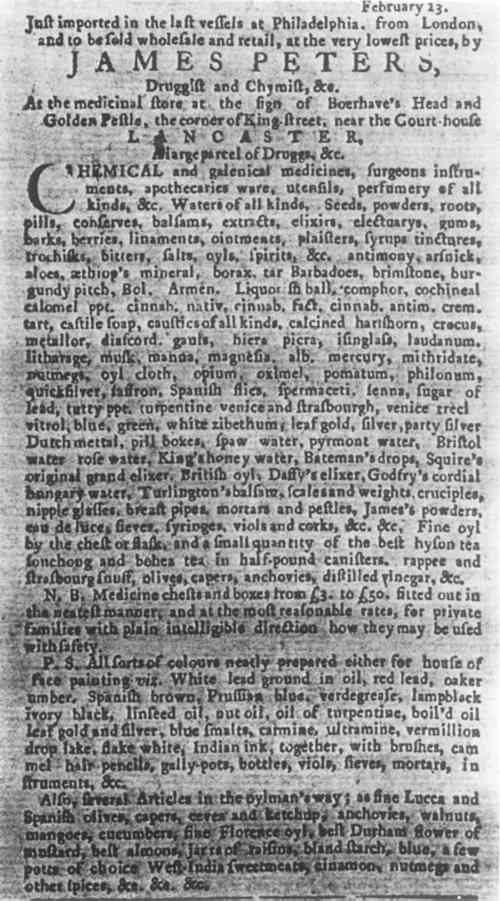PIGMENT ANALYSIS OF EARLY AMERICAN WATERCOLORS AND FRAKTURJanice H. Carlson, & John Krill
2 HISTORICAL BACKGROUNDTHE FIRST GROUP of Germans to arrive in Pennsylvania came in 1683, just two years after Charles II granted a charter for the land to William Penn. Some of them heard Penn speak on a missionary trip which he made to Germany in 1677; Penn, a zealous Quaker, saw Pennsylvania as a “Holy Experiment.” The Germans settled in what was aptly called Germantown, which remained the boundaries of their immigration until about 1710. By 1717, the incoming Germans had begun to generate concern in the predominently Quaker and English city of Philadelphia. In 1727, an estimated 15,000 to 20,000 Germans were living in the colony.1 The height of the immigration was reached around 1750 with as many as twenty-two ships of Germans arriving a year.2 Between 5 and 10% of these Germans were “plain people” such as the Amish and Mennonites; the majority of the rest were “church people” such as the Lutheran and Reformed. Interestingly, this latter group produced most of the fraktur. At mid-century The contributions of the eighteenth century German settlers were rich and varied. They provided much of the trade in the prominent and rich city of Philadelphia. They introduced many modern agricultural methods. Their printers produced more books than those of New England and New York combined. Benjamin Franklin began a German newspaper for them in 1732, and also in Philadelphia, cabinetmakers printed their message in English and German on the same furniture label. Education was important to the Germans. Communities are known to have built a schoolhouse before building a church. The penmanship sheets of writing specimens by the schoolmaster were teaching aids of the time. Awards of merit, too, were made by him. These manuscripts are fraktur. Other forms of fraktur include birth and baptismal certificates, house blessings and family records. The first person to write about fraktur and bring it toward the fore was Henry Mercer, who, in 1897, said the following about a paint box used for fraktur:
The implications from this, that fraktur were produced from farmyard products, have continued to the present day. Gilbert, in 1971, said, “Fortunately there were teachers trained in the art of fraktur who could instruct their pupils to write the alphabet and to illustrate the letters with homemade paints. Vegetable, plant, and berry dyes were probably used… .”5 Unfortunately glossed over by some was Mercer's comment in a catalog description in another presentation that, “the old paints were bought from apothecaries in Philadelphia and kept in bottles.”6 Among the scholars whose theories were that fraktur makers used known artist pigments is Frances Lichten. In a 1963 lecture on fraktur she said that she, as an artist, could easily recognize by eye the presence of such widely used pigments as vermilion, Prussian blue, gamboge and orpiment.7 Earlier, in 1937, Henry Borneman
Borneman shares with us Johann Krauss's Haus und Kunst-Buch published in 1819 in Allentown, Pennsylvania. Krauss wrote of the use of carmine, annotto, Prussian blue, verdigris, and other colors. Also presented by Borneman is Ambrosius Henkel's Das Grosze ABC Buch, published in New Market, Virginia, which recommends Brazil wood, verdigris, and indigo. Artists' colors were available to the countrymen through several sources. They came through local shops and peddlers, by special order from abroad (there was much correspondence to the homeland at that time) and from large cities. A newspaper advertisement, shown in Figure 3, in the Pennsylvania Journal, March 29, 1764, placed by James Peters, druggist and chemist in Lancaster, tells of items “Just imported in the last vessels at Philadelphia, from London… .” Included in the list are white lead, red lead, ocher, umber, Spanish brown, Prussian blue, verdigris, lamp black, ivory black, smalt, carmine, ultramarine, vermilion, flake white, and Indian ink.9 In the 1820's, domestic watercolors became available. These were first manufactured in America by the Osborne Company in Philadelphia.10
Also imported was paper. Since the beginning of the colonies, paper had arrived from abroad in a strong continous stream. The only major obstruction to this flow was from 1765 (the Stamp Act) through 1783 (the end of the American Revolution). After the war, paper resumed its course from Europe with such breadth that by the third decade of the nineteenth century its competition caused some drastic reductions in America's paper industry.11 That imported and domestic papers have been found used with fraktur is not surprising. Many early American paper-makers were Pennsylvania German, including the first, Wilhelm Rittenhouse, whose mill was erected near Germantown in 1690. So we see that the Pennsylvania Germans' use of imported papers and paints is in harmony with their other, often progressive, contributions to their new world. As a foreign traveler in the eighteenth century noted: they must have been princes as their barns were so big!12 |
